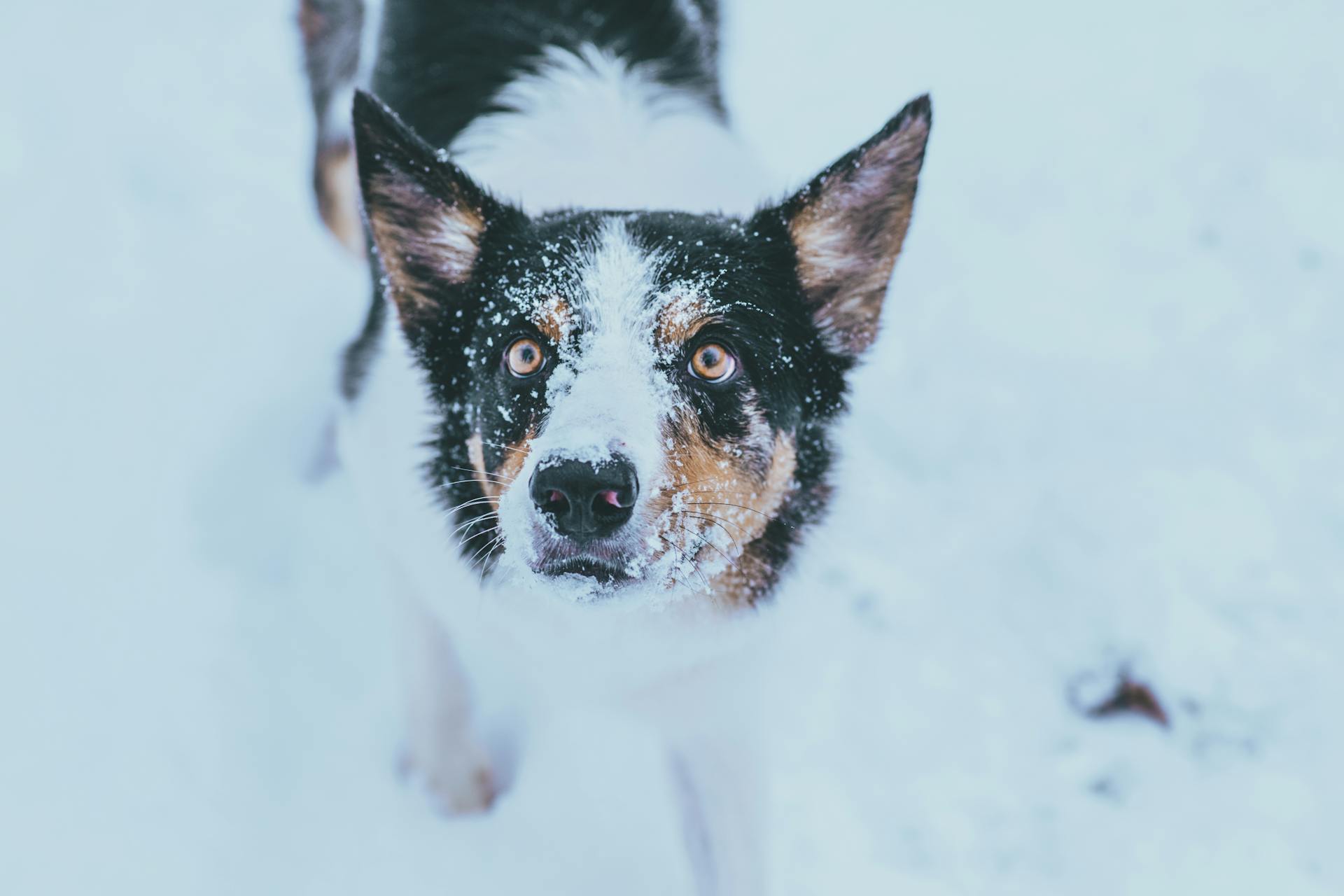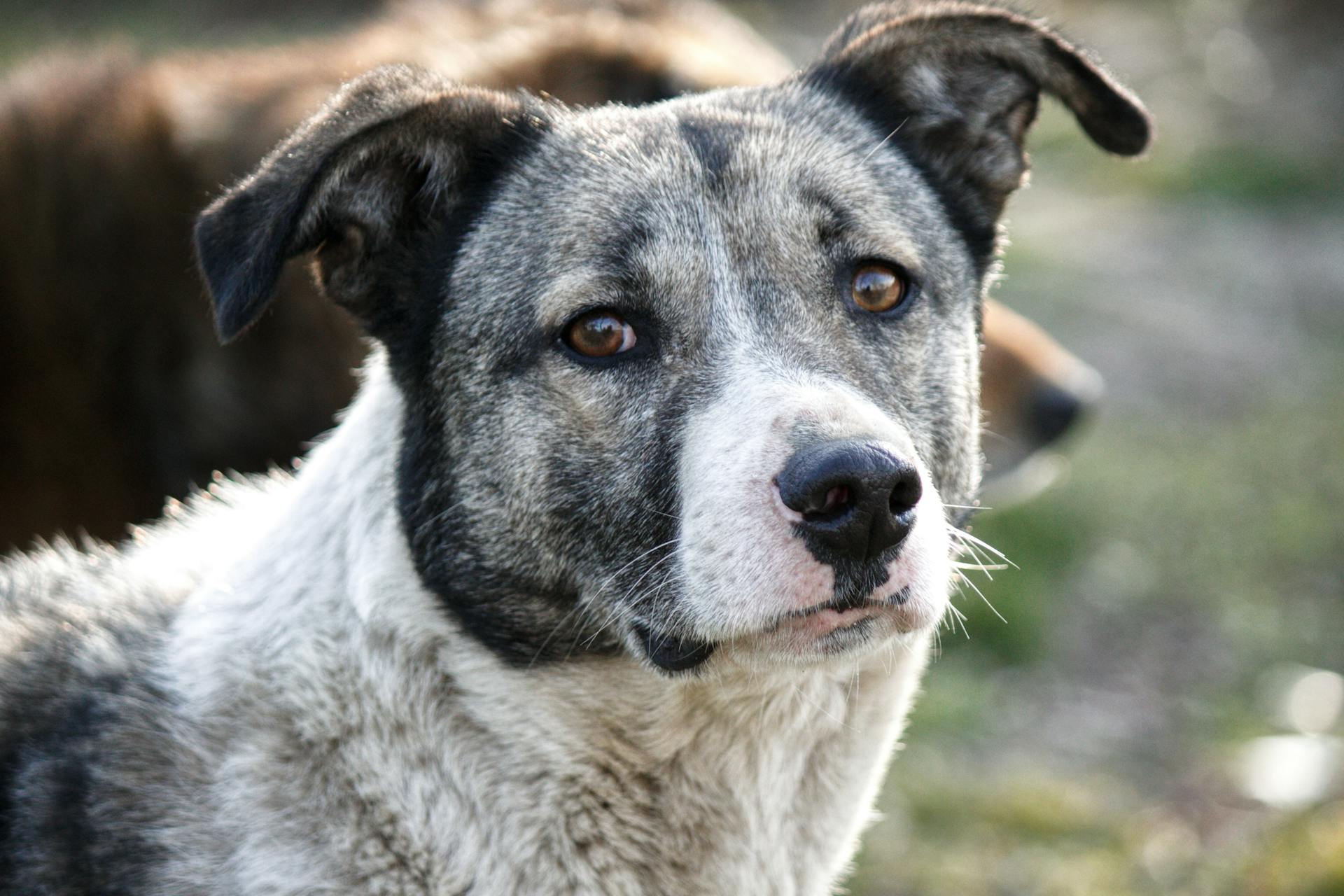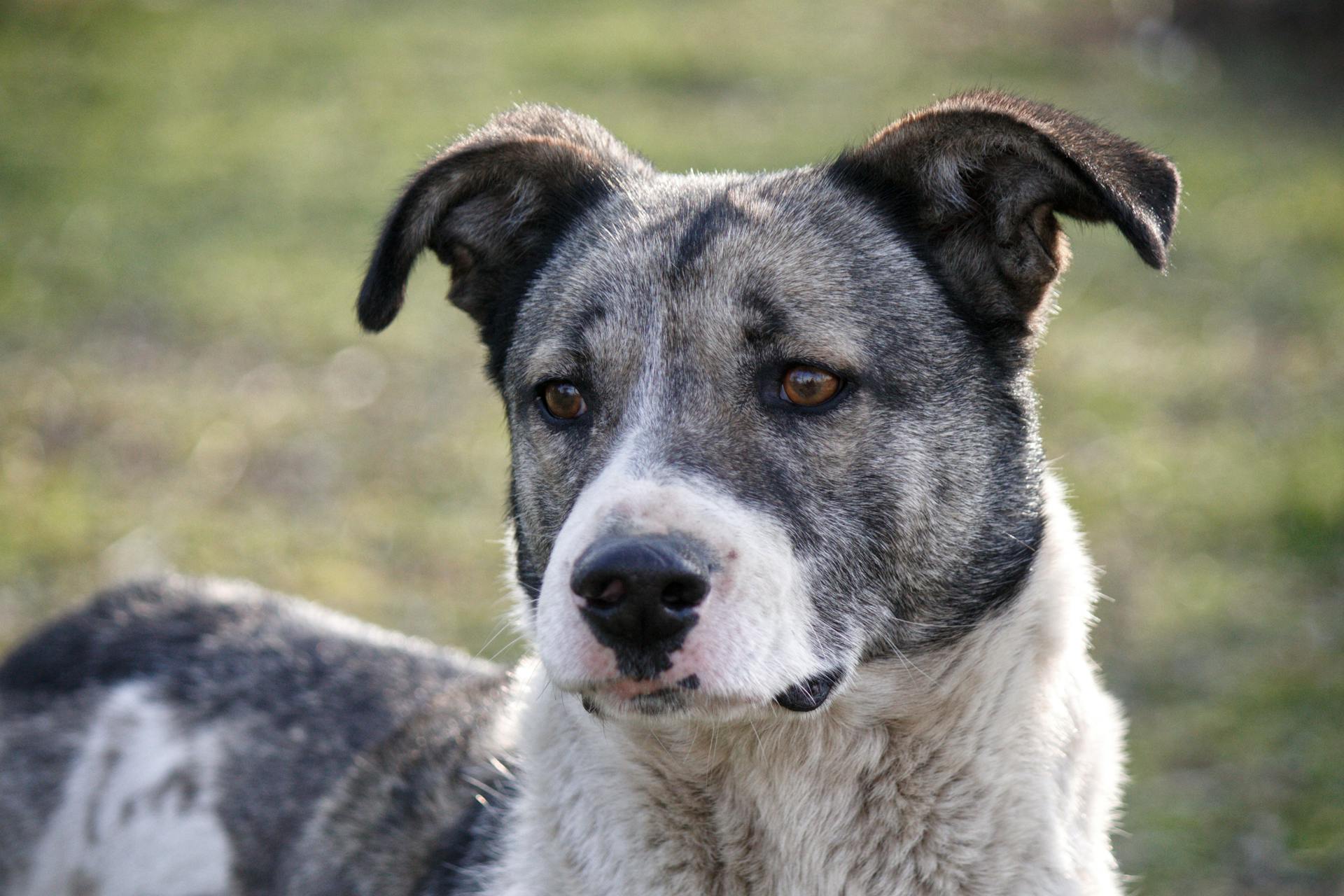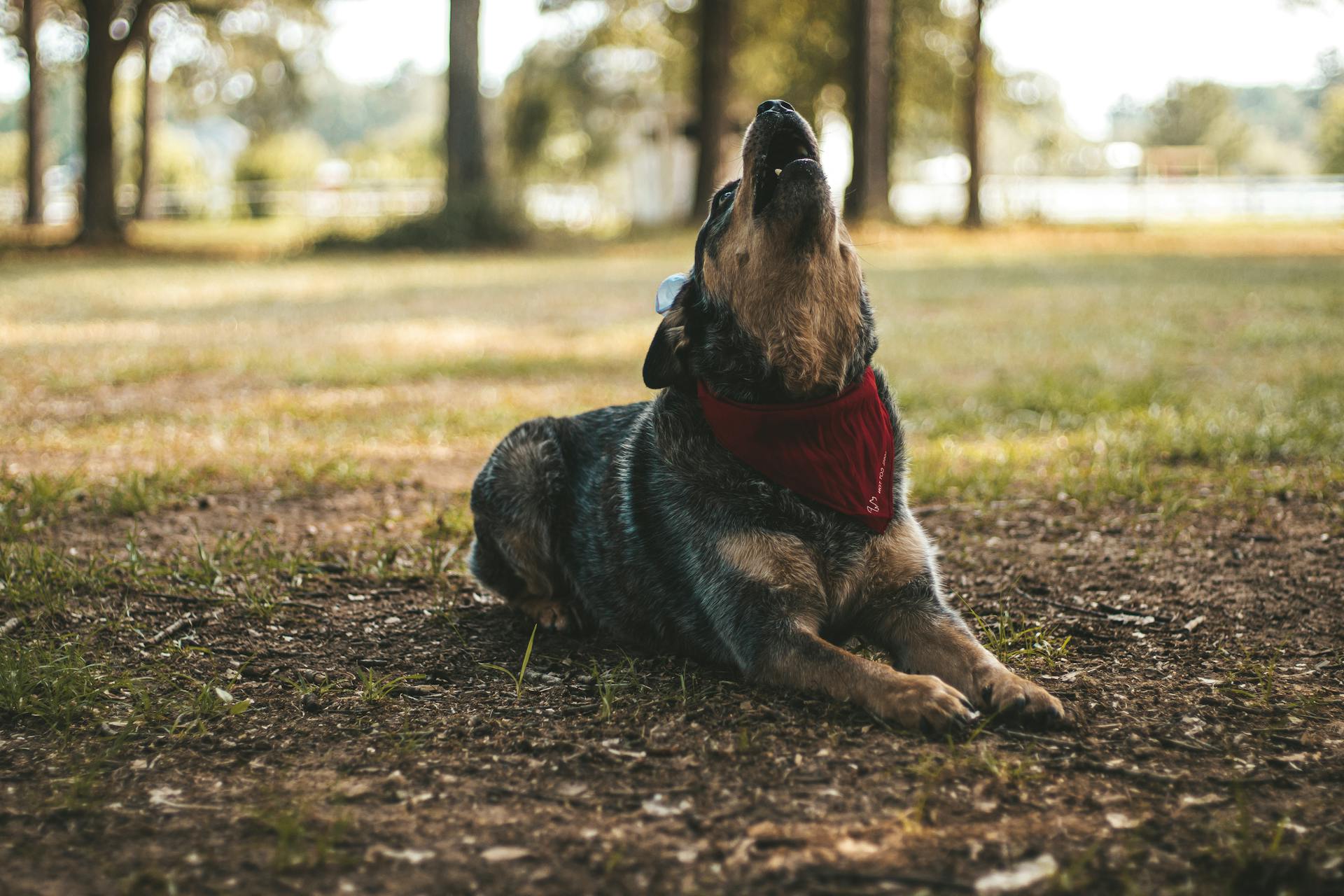
Red Heeler mixes can make wonderful pets for active families.
They require regular exercise to stay happy and healthy.
A daily walk of at least 30 minutes and some playtime should be part of their routine.
Some Red Heeler mixes may inherit the high energy level of their Australian Cattle Dog parent.
These dogs need plenty of space to run around and play.
A securely fenced yard is a must to prevent them from escaping or getting into trouble.
Physical Characteristics
Red Heeler mixes are a delightful combination of breeds, and their physical characteristics are just as fascinating. They typically stand between 17 and 20 inches tall, with males often being a few inches taller than females.
Their weight can range between 35 to 50 pounds, with some mixes reaching their full size and weight by around 18 months of age.
Red Heeler mixes are athletic and muscular, with a broad head and powerful jaw. Their ears are set apart on the top of their head, much like a German Shepherd's ears.
Their coat can vary in length, but it's often short to medium length. They may inherit the double coat of their Australian Cattle Dog parent, with a dense undercoat.
Red Heeler mixes can come in a range of colors, including red, blue, and tan, with some mixes also having black and white markings.
Here's a summary of their physical characteristics:
With their athletic build and short coats, Red Heeler mixes are perfect for active families who enjoy outdoor activities. Their intelligence and energy levels make them a joy to be around, and with proper training and care, they'll thrive as loyal companions.
Traits and Personality
Red Heeler mixes are known for their high energy levels, which means they need plenty of playtime to stay happy and healthy. They're also super smart, making them quick learners.
One of the best things about Red Heeler mixes is their loyalty to their families. They'll stick by your side and love to be around their favorite people. They can be a bit reserved around strangers, so socialization is key.
Red Heeler mixes have a strong prey drive, which means they might chase small animals if they see them. This is because they're a working breed and were originally bred to herd cattle. They'll need plenty of mental and physical stimulation to keep them occupied.
Here are some key traits to expect from a Red Heeler mix:
Red Heeler mixes are generally healthy, but they can inherit health concerns from their parent breeds. Regular vet check-ups are a must to catch any issues early.
Health and Grooming
Red Heeler mixes are relatively low maintenance when it comes to grooming. They only need to be brushed once a week with a slick brush to remove loose hairs and keep them looking tidy.
They don't need to be bathed often, unless they've gotten into something stinky, and regular nail trimming will keep their nails in check. Brushing their teeth as often as possible can also prevent gum disease.
These dogs are smart and determined, but they can be independent at times, so consistent, positive training methods are a must. Socializing them with various people and animals is crucial to help them become well-rounded adults.
Common Health Issues
As an owner of an Australian Cattle Dog, also known as a Red Heeler, you want to be aware of the common health issues that can affect your furry friend.
Hip dysplasia is a major concern, where the hip bones don't fit together perfectly, causing arthritis or pain. Regular check-ups with your vet can help catch this issue early on.
Deafness is another condition that can affect Australian Cattle Dogs, especially as they age. It's essential to keep an eye out for this and address it promptly.
Progressive retinal atrophy is a fancy term for an eye condition that can slowly cause blindness. This is a serious condition that can be managed with regular check-ups and medication.
Here are some common health issues to watch out for:
- Hip dysplasia
- Deafness
- Progressive retinal atrophy
Remember, regular vet check-ups and a healthy lifestyle can go a long way in preventing or managing these conditions.
Grooming Needs
Grooming needs for your dog are pretty straightforward, but regular brushing is essential to keep their coat looking tidy.
They'll need to be brushed once a week with a slick brush to remove loose hairs and prevent matting.
You'll also need to clip their nails every so often to keep them from getting too long.
Brushing their teeth as frequently as possible will help prevent the buildup of decay that could lead to gum disease.
Some dogs don't like to be groomed, so establishing a routine from a young age can be really beneficial.
They might not need to be bathed very often, but it's a good idea to do so if they've rolled in something unpleasant.
Their shedding can be moderate all year round, but they might shed more heavily twice a year.
Health
Your Heeler's diet is crucial to their overall health and energy levels. They require high-quality dog food rich in protein to support their muscular build.
Puppies under six months need to be fed 3-4 smaller meals throughout the day, while adult dogs typically require two meals a day.
Feeding your Heeler between 1,000 to 1,500 calories per day is a good starting point, which translates to around three cups of food a day. However, this may vary depending on their weight and activity level.
To ensure your Heeler is at a healthy weight, you should be able to see a waist when looking at their body, and you should be able to feel their ribs without pressing too hard.
Here's a quick guide to help you determine your Heeler's meal frequency based on their age:
- Puppies (under six months): 3-4 meals per day
- Adult Dogs: 2 meals per day
Mental and Physical Stimulation
Red Heeler mixes are intelligent dogs that require mental stimulation to prevent boredom and destructive behavior. They thrive on activities that challenge their brains, such as puzzle toys and obedience training.
To keep your Red Heeler mix's mind active, you can try teaching them new tricks or engaging them in interactive games. With consistent practice, they'll stay sharp and engaged.
A daily playtime routine of at least 30-60 minutes is essential to keep your Red Heeler mix physically active and happy. This can include activities like long walks, runs, and fetch.
Here's a breakdown of a daily playtime routine for your Red Heeler mix:
- Daily playtime routine: A minimum of 30-60 minutes.
- Training sessions: Short, 10-15 minutes, a couple of times a day.
By providing your Red Heeler mix with adequate mental and physical stimulation, you'll be able to prevent boredom and destructive behavior, and strengthen your bond with your furry friend.
Training and Socialization
Red Heeler mixes are intelligent and eager to please, making them a joy to train. They thrive on positive reinforcement and reward-based training, which includes verbal praise and treats.
Consistency is key when training your Red Heeler mix. Start early, as they are strong-willed and can get distracted easily. Positive reinforcement works wonders, and you'll find that your mix is eager to impress you.
Socialization is also crucial, especially since Red Heeler mixes may inherit the Australian Cattle Dog's caution around strangers and the Border Collie's sensitivity. Introduce them to different people, dogs, and experiences early on to ensure they grow up to be well-rounded adults.
Here are some specific training tips to keep in mind:
- Teach basic commands like sit, stay, and come to manage their strong herding instincts.
- Direct their natural herding instinct into a safe and controlled activity.
- Replace nipping behavior by giving them a toy or bone to chew instead.
Remember, Red Heeler mixes need both physical exercise and mental stimulation. If you can provide plenty of both, you're likely to have a very happy and healthy companion by your side.
Care and Maintenance
Exercise is key for red heeler mixes, they love walks, games, and activities that challenge their mind. Regular brushing helps to keep shedding under control.
Mixed breeds often enjoy 'hybrid vigor,' making them potentially healthier than their purebred counterparts. This is a great benefit to consider.
Start training early, as red heeler mixes are smart and can sometimes have a stubborn streak. Positive reinforcement works wonders with this mix.
Introduce them to new people and pets early on to ensure they're well-rounded adults. This will help them grow into confident and social companions.
To keep your red heeler mix happy and healthy, remember to always have fresh water out for them to drink.
Family Compatibility

Red Heeler mixes can make excellent family pets, but they do require a lot of exercise and attention.
They thrive with families who enjoy outdoor activities like hiking or jogging, and having a large yard or area to run around in is a must.
Red Heelers can be protective of their family and wary of strangers, but proper socialization can help mitigate this.
If you have young children, it's best to wait until they're at least 10 years old before bringing a Red Heeler mix home, as they can exhibit herding behavior around small kids.
Socializing with your Red Heeler mix can help them adjust to younger children, but it's still essential to be patient and consistent.
Red Heeler mixes shouldn't be kept with other dogs or animals, as they can be hostile towards them and exhibit herding behavior.
However, with the right training and patience, they can learn to coexist peacefully with other pets and small children.
A unique perspective: Red Heeler Behavior Problems
Choosing and Caring for a Red Heeler Mix
Choosing a breeder is a great place to start if you're looking for a puppy. Research the breeder's reputation and ask for health clearances to ensure you're getting a healthy pup.
Exercise is key for red Heeler mixes, they love walks, games, and activities that challenge their mind. Regular brushing helps to keep shedding under control, but don't worry, they don't need a lot of grooming.
A solid routine that includes a good diet, comfy living conditions, and plenty of fun activities will keep your red Heeler mix happy and healthy. Remember to always have fresh water out for them to drink.
Here are some tips for introducing your red Heeler mix to new people and pets:
- Introduce them to new people and pets early on to ensure they're well-rounded adults.
- Start training early because these dogs are smart and can sometimes have a stubborn streak.
Positive reinforcement works wonders with this mix, so be patient and consistent with training.
Choosing a Breeder
Researching the breeder's reputation is crucial. Check out the American Kennel Club (AKC) as they can help connect you to breeders who meet their high standards.
To ensure you're getting a healthy puppy, ask for health clearances from the breeder. Meeting the parent dogs is also a great idea.
Here are some key things to look for in a breeder:
- Research the breeder's reputation.
- Ask for health clearances and meet the parent dogs.
By taking the time to find a reputable breeder, you'll be more likely to get a happy and healthy Red Heeler Mix puppy.
Final Thoughts
As you bring a Red Heeler Mix into your family, remember that they need your attention and a job to do, or they might just find their own (and not always the kind you'd pick!).
These dogs have energy to burn, so be prepared to keep up with their exercise needs. They love to run and play, so a good yard or frequent trips to the park are a must.
With their super smart nature, training might actually be a fun challenge for you both. They're known for their determination and intelligence, so be patient and consistent.
Here are some key needs to consider:
- Exercise: A good yard or frequent trips to the park are a must.
- Training: They're super smart, so training might be a fun challenge for you both.
- Space: They need room to run and play.
Ultimately, love your Heeler and give it the care it deserves. You'll have a faithful buddy for life.
Frequently Asked Questions
How big do red heelers get?
Red Heelers typically stand 17 to 20 inches tall and weigh 35 to 50 pounds. Their medium size makes them a sturdy and active breed.
Sources
- https://www.k9ofmine.com/australian-cattle-dog-mixes/
- https://animalcorner.org/dog-breeds/red-heeler-australian-cattle-dog/
- https://www.dogster.com/dog-breeds/red-heeler
- https://pawsafe.com/blogs/dog-breeds/16-best-australian-cattle-dog-mixes
- https://www.cuteness.com/article/chihuahua-heeler-mix-information
Featured Images: pexels.com

